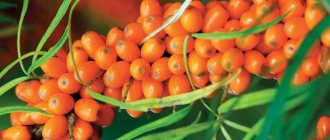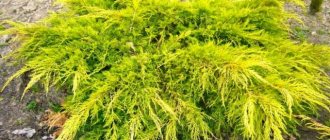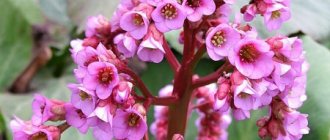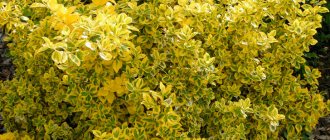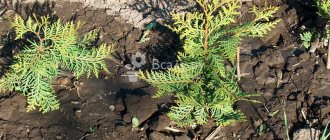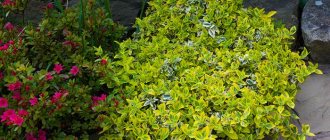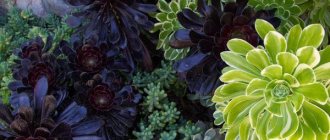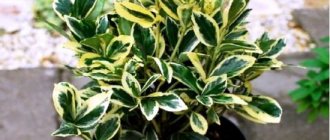Photos of Fortune euonymus varieties, features of planting and care
Evergreen trees and shrubs have long been a “highlight” in the landscape design of plots.
Maintaining foliage all year round, these plants are always eye-catching and often become key design elements, especially when it comes to variegated plants such as Fortune's euonymus or some varieties of Japanese euonymus. Euonymus fortunei or Fortune's euonymus is a low-growing shrub native to China. Its branches spread along the ground and can reach a length of several meters, while the height of the bush itself does not exceed 60 cm. Adventitious roots develop on the shoots, with the help of which the lashes can cling to various supports or take root when in contact with the soil. The leaves of this species are leathery and rather hard, slightly tapering towards the end of an oval shape. Their sizes do not exceed 3-4 cm, and their color is two-color, changing depending on the season of the year.
In spring, in addition to variegated leaves, the plant produces greenish-white, waxy flowers, which by August turn into inconspicuous, poisonous fruits. The flowers and other parts of the euonymus are also poisonous.
Features of caring for the colorful Euonymus tree at home and in the open ground
Euonymus is a tree that captivates the eye with its colorfulness. In nature, there are approximately two hundred species of such a bright plant.
It has gained popularity due to its ability to decorate gardens, but connoisseurs of flora often wonder about growing it at home.
The following are photos of indoor Euonymus:
Common varieties
Based on the natural appearance, various varieties have been created to meet various landscape design tasks. They differ in foliage color, height and growth rate.
"Emerald Gold"
Fortune's euonymus " Emerald 'n' Gold " (or "Emerald in gold") forms bushes up to half a meter in height. The name of the variety best describes the color of the foliage of this shrub. The small oval leaves have a bright green center and golden edges, turning reddish-brown in the fall. The shrub grows slowly, but is suitable for vertical gardening - its vines can “climb” to a height of up to 2 m. Although the frost resistance of this variety is quite high, the plant can die in a particularly harsh winter.
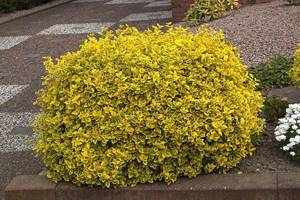
"Minimas" ("Baby")
The creeping variety of euonymus Fortune "Minimas " is a slow-growing variety and reaches a height of only 15-20 cm. The shoots of the plant are very thin, and the shiny leathery leaves barely exceed 1 cm in size. The color of the foliage is dark green all year round. This variety forms a dense “cushion” crown and is used as a ground cover plant.
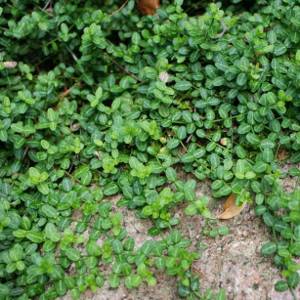
"Vegetas"
“Vegetus” (“Vegetas”) is a relatively tall variety, the bushes of which rise above the ground by 50-60 cm. Compared to other varieties, it has large (up to 4-5 cm) leaves, the surface of which is matte, and the veins stand out in green background in the form of a white or light green grid. It grows quickly and forms dense thickets, which is used to create imitations of a lawn and low living borders.
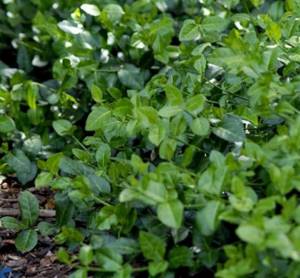
"Emerald Haiti"
“Emerald Gaiety” (“Emerald Haiti”) is a variety whose bushes do not take up much space and reach a height of 25 cm. The ovoid leaves have a bright green core and a slightly uneven border along the edge, white in spring and summer, and acquiring a pink tint in autumn . It grows at an average speed and quite quickly forms a dense “carpet”. This species is perfect for northern regions as a ground cover.
Types and varieties of euonymus
There are many types of euonymus in nature, and there are many of them in culture. We offer you an introduction to cultivated species of euonymus, as well as their varieties. Let's start with the types that have already been mentioned in this article.
Euonymus verrucosa (Euonymus verrucosa)
Distributed in nature in the European part of Russia, in the mountains of Southern, South-Eastern and Central Europe. It is a shrub up to two meters high or a tree five to six meters high with bright green shoots and branches strewn with black warts. The leaves are light green, the flowers are brownish in color, the fruits are pink with red-brown buds. In autumn, this species is especially attractive: the leaves turn pink on the bright green shoots. Euonymus warty grows slowly, it is shade-tolerant and unpretentious, and is often used in ornamental gardening.
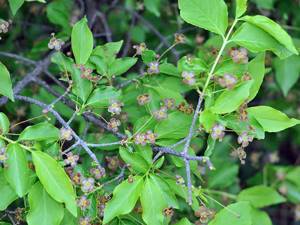
European Euonymus (Euonymus europaea)
Grows in Europe and Asia Minor on any soil in deciduous forests and high on slopes. It is a small tree up to six meters high, most often growing as a bush. Young shoots of this species are green, sometimes with longitudinal corky growths, and old branches are almost black. The ovate or obovate leathery leaf of the European euonymus, up to 11 cm long, has a dark green color, and in the fall it acquires a red tint. The fruits are pink or dark red when ripe, the seed is covered with an orange apex.
This species is drought-resistant, winter-hardy, and tolerates urban gas pollution well. The European euonymus in the garden stands out against the background of the usual yellow-golden color of other plants in autumn. More than 20 decorative forms of this species are known, characterized by less winter hardiness: weeping, dwarf, aucubifolia, intermediate, purple, silver-spotted and others.
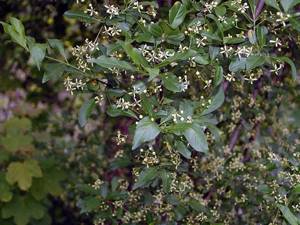
Winged euonymus (Euonymus alata)
It grows in groups or singly on rocks, in river valleys and along mountain streams, as well as in shady deciduous forests of China, Japan, Korea and Southern Sakhalin. It is a highly branched shrub up to 2.5 meters high or a tree up to 4 m high with tetrahedral branches with light gray bark, shiny obovate or rhombic leathery leaves of dark green color and small greenish flowers collected in threes in an inflorescence. Ripe boxes are bright red. The species has about 20 forms and varieties. The most famous of them:
- Compactus is a small shrub, not exceeding two meters in width and height, with a compact dome-shaped crown and inconspicuous flowers. The leaves are oval, light green, changing color to bright red in autumn, the fruits are red, the pericarps are orange. Winter-hardy, but sensitive to drought and overheating.
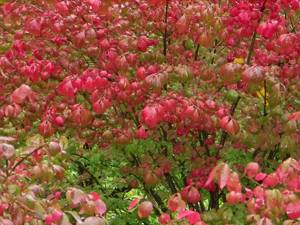
The use of Fortune's euonymus in landscape design
Due to the presence of many original varieties, this shrub is widely used in landscaping. This is both a soloist plant and a participant in group plantings next to other evergreen or deciduous representatives of the flora. Euonymus is used to create imitations of lawns and miniature hedges. This species goes well with winged euonymus.
- Varieties such as “Silver Quinn”, “Vegetas”, “Emerald Haiti” are suitable for creating hedges and borders.
- Large specimens with a cushion-shaped crown are suitable as solo plants and for creating small group compositions.
- Tall varieties look great in the middle and background of flower beds, and decorate the perimeter of flower beds as dwarfs.
- Low-growing varieties go well with the stones of alpine hills and rockeries.
- Almost all varieties of Euonymus fortunei serve as ground cover plants, for example, “Harlequin” is an excellent substitute for a lawn in shady corners of the garden, and the “Minimas” variety is good as a border along well-lit paths.
- It is also used for vertical gardening. In this case, the plant lashes need to be additionally secured to supports. Varieties such as Emerald Gold, Coloratus, Darts Blanket and Vegetas are suitable for these purposes.
Pests of euonymus
In order to always be on the alert and notice the first signs of insect damage or disease in time, you need to familiarize yourself with them in more detail. The main thing is to make sure that you do not accidentally harm beneficial insects and birds when treating with drugs. Therefore, it is better to use natural substances rather than chemicals. And so, to your attention common pests of euonymus, their description and methods of combating them.
Shields
Scale insects are brown insects that feed on the sap of leaves. Because of the scale insects, the leaves change color, become pale, and eventually dry out and fall off. To get rid of this pest, it is necessary to treat the euonymus with actellik mixed with water. If scale insects are not removed in time, a lot of them will form on the leaves, so you will not be able to remove them yourself. After treating the plant with the drug, pick off the damaged leaves and destroy them.
Spider mite
The insect spider mite forms a cobweb on the stems, due to which the leaves wither, dry out and fall prematurely. To get rid of the pest, you need to wash the plant with a sprayer, not with strong pressure, so as not to harm the leaves. You can also soap a small washcloth and wipe the damaged leaves. If it doesn’t help, use Actellik and regularly treat the euonymus with it.
Red flat tick
This pest is completely invisible, which complicates the task of fighting it. But, if it infects your euonymus, you will notice crooked and light spots. When damaged by a red flat mite, shoots and foliage deteriorate. To get rid of the pest, it is necessary to treat the plant with an insecticide.
Mole
The moth is a small silvery-white butterfly with wings covered with black dots, warts and hairs. Her babies may be yellow or green. This insect is especially harmful to leaves; it eats them right down to the veins. In July, the moth lays its eggs on the bark, causing it to become covered with a brown liquid. To get rid of moths, you must first get rid of nests and cocoons. For treatment, it is recommended to use special preparations: “Inta-Vir”, “Fitoverm”, “Kinmiks”, “Iskra”, “Fufanon”.
Brown aphid
The full name of this pest is brown euonymus aphid. This insect is quite small in size; its brown body is covered with a waxy coating. Aphids feed on leaf sap, sucking it out. At the same time, the leaves themselves become yellow and curled, dry out prematurely and fall off. To combat brown aphids, you need to use a special preparation: “Fitovrem”, “Kinmiks”, “Fufanon”, “Iskra”, “Inta-Vir”. If brown aphids have bypassed your euonymus, gardeners still advise treating the plant with a special preparation for preventive purposes.
Landing
Features of planting and caring for Fortune's euonymus come down to following a few simple rules:
- The best time to plant the plant is the end of April or the beginning of May, in which case the euonymus has time to take root and prepare for the upcoming winter. Planting in the fall is also possible, but the likelihood of death of individual specimens increases.
- Almost all varieties of Euonymus fortunei are light-loving, and with a lack of light, their variegated leaves quickly turn into ordinary green, so it is important to choose places with enough sun. The exception is the Harlequin variety, which prefers shaded areas of the garden.
- Representatives of this species cannot be planted in lowlands and places where water accumulates - euonymuses do not tolerate excess and stagnation of moisture. Therefore, even when designing a zone near a reservoir, they are planted at a sufficient distance from the water.
There are no special requirements for the soil, the important condition is that it should be light. The reaction of the environment is best neutral or slightly alkaline; in acidic soil, the plant quickly loses its decorative effect and withers. Therefore, if the garden soil does not meet these parameters, it is necessary to prepare a soil mixture.
- In order to make the soil “lighter”, sand and peat are added to it, and the addition of dolomite flour or ash helps reduce the acidity of the soil.
- It is not picky about soil fertility, but performs better in nutritious soils. Therefore, humus and mineral fertilizers for evergreens are added to the soil mixture.
Planting holes or trenches are prepared only if the garden soil is for some reason not suitable for the plant. In other cases, the soil is simply dug up “on the bayonet of a shovel” and a small amount of humus is added.
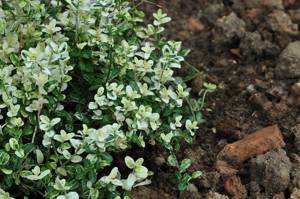
The plants are planted at the same depth as they were in the containers - without deepening the root collar. The soil around is slightly compacted and shed with water, and after drying, the tree trunk circle must be loosened. It is advisable to mulch the soil surface.
It is interesting that euonymus is a shrub that tolerates crowding, and therefore a minimum distance can be maintained between seedlings (this depends on the size of the specimens and the idea of the composition).
It will be useful to read:
Fortune's euonymus is an unpretentious plant; it can tolerate short-term drought, and it requires regular watering only in the first year after planting and in the event of a long absence of rain. Key points in caring for Euonymus fortunei:
- The soil should have time to dry out between waterings.
- Periodically, you need to loosen the soil around the plants - the euonymus has a shallow root system, and soil compaction negatively affects it.
- Mineral fertilizing is applied twice per season - in May and in August-September. Organic matter in the form of humus or compost is mixed into the circle around the trunk during the summer, but it is important not to overdo it here - excess nitrogen has a bad effect on the decorative appearance of plants with variegated leaves.
- Euonymus is a shrub that does not need a shaping pruning, but dead or diseased branches should be removed, as well as shoots that are too long should be trimmed.
Euonymus care
Growing euonymus
Watering the euonymus is carried out as needed. To make it easier for you to care for your euonymus in the garden, mulch the tree trunk circle with dry soil immediately after watering. Subsequently, loosen the soil in the tree trunk circle a day or two after watering at least three times a season. But if it rains regularly, do not water the euonymus at all - it does not need a lot of water, and excess moisture in the roots will only harm it. Caring for euonymus involves feeding the plant twice a day during the spring-summer season with mineral fertilizers: the first time in the spring, the second time in the fall.
Reproduction of Euonymus fortunei
It is most easily propagated by summer layering. The creeping shoots of this plant cling to the ground with the help of adventitious roots, and if such a shoot is separated from the mother plant, then over time it develops a real root system. And since adventitious roots are located along the entire length of the branches, several young plants can be obtained from one lash at once.
The second most common method of propagating Fortune's euonymus is cuttings. Cuttings 5-10 cm long are cut from non-lignified shoots in mid-summer, treated with root formation stimulants and planted in a peat-sand mixture under a film. Rooting lasts about a month, after which the young plants are planted in a prepared place where they will overwinter. In the spring, you can transplant new specimens to a permanent place.
It is also propagated by dividing the bush. To do this, in the spring, an adult bush is carefully dug up and divided into several parts so that each has a root system, shoots and growth points. The cuttings are sprinkled with coal, and new plants are planted in the selected places.
The above methods of propagation are good not only because they are fast, but also because the new bushes retain the varietal characteristics of the mother plant. This shrub can be grown from seeds, although the process is quite difficult and preservation of varietal characteristics is not always guaranteed.
First of all, seeds need long-term stratification:
- Planting material is soaked in a weak solution of potassium permanganate for several hours, then the seeds are placed in sand and kept for about three months at a temperature of about 10⁰C (for example, in winter, you can place a bowl with sand and seeds on an insulated loggia).
- The next stage is to keep the seeds at a temperature of 3⁰C for 4 months, during which time the skin on the seeds should burst.
After all procedures, the seeds are sown in a peat-sand substrate or a mixture of turf soil and sand. Shoots appear within 2-3 weeks. In the future, for the first 2-3 years, young plants can be grown in containers, or, after several pairs of true leaves appear, they can be planted in a special bed in open ground.
Pests and diseases of euonymus
An incredibly beautiful plant that you buy and take care of in order to wait until the time of flowering and fruiting in order to enjoy this spectacle! And how unpleasant it is when the time comes and you observe something completely different from what you expected. Unfortunately, like all plants, euonymus can be damaged by insects and diseases. The pests of this plant include spider mites and aphids, due to which the leaves are deformed and lost. Also pests are codling moth and mealybug. Their appearance leads to the destruction of the leaves on which they feed. The main thing is to care for the euonymus in a timely manner and monitor whether the first signs of disease have appeared. If you provide the bush with attention, you will get a wonderful and irreplaceable decoration for your garden or yard.
By the way, it is very effective to plant euonymus next to apple trees, as it protects them from damage by insects.

